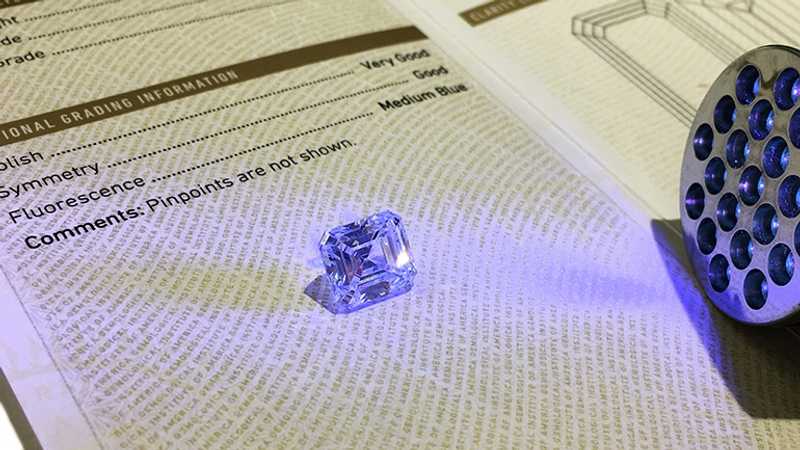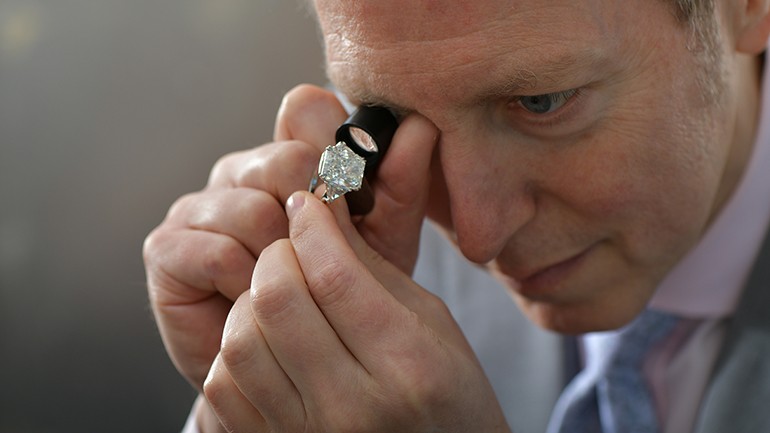What is Diamond Fluorescence
How Does it Affect Value?

What is Diamond Fluorescence and How Does it Affect Value?
Fluorescence may not be one of the 4Cs, but it is still one of the more important characteristics to be considered in a diamond. The presence of fluorescence, or the lack of it, can impact the overall beauty, and therefore the value, of a diamond. While there are many different qualities a diamond can possess, even an ideal diamond - vibrant, bright, and full of life - with excellent clarity, color, and cut can be less valuable because of the presence of fluorescence. So, what exactly is diamond fluorescence, and why does it have such impact on a diamond’s value?
What is Diamond Fluorescence, and is it Good or Bad?
Diamonds with Faint or Medium fluorescence can have the appearance of a slight haziness. Usually fluorescence is blue in color. Less often, a diamond can have yellow or even white fluorescence (other colors too). Diamonds with Strong - or Very Strong - fluorescence can appear quite cloudy, milky or hazy to the naked eye, and emit a prominent and saturated glow in the presence of UV light. Only about ten percent of all diamonds have some level of fluorescence.
Recently, the presence of fluorescence in any amount has been greatly scrutinized by the trade and the public alike. It was not always this way. In fact, only twenty years ago, unless a diamond’s appearance was significantly affected by the presence of fluorescence, most buyers didn’t mind the rather inert visual impact. Only recently has this quality pushed the value of diamonds that exhibit it downward. Many would say that it’s overkill that these diamonds are devalued at all.
So, is diamond fluorescence good or bad? Well, that depends. The more expensive diamonds (large and high color, think D-E-F) are far more valuable when they exhibit no fluorescence. But for most other diamonds, especially diamonds with Faint fluorescence, this phenomenon rarely impacts the diamond’s visual nature. So, the presence of fluorescence, while never considered positive by itself, sometimes has little or no negative impact, depending on the other characteristics of the diamond and the appeal of the overall beauty.
How is a Diamond’s Fluorescence Grade Determined?
The Gemological Institute of America (GIA) will grade a diamond’s fluorescence based on its intensity. The grades on the diamond fluorescence scale from best to worst are:
- None: Diamonds with no fluorescence present will receive a grade of None.
- Faint: Diamonds with Faint fluorescence exhibit a very slight amount of fluorescence. It is usually not detectable to the unaided eye, and can emit a very subtle blue hue under UV light.
- Medium: Diamonds with Medium fluorescence will have a stronger blue glow under UV light. It is usually not detectable to the unaided eye, but can cause a diamond to appear slightly, cloudy, milky, or hazy to the naked eye.
- Strong: Diamonds with Strong fluorescence emit a substantial and intense blue hue under UV light, and can cause a diamond to appear very cloudy, milky, or hazy to the naked eye.
- Very Strong: Diamonds with Very Strong fluorescence exhibit a prominent and saturated blue hue under UV light and can cause a diamond to appear substantially very cloudy, milky, or hazy, to the naked eye.
How Does A Diamond’s Fluorescence Affect its Value?
Lower color ranges aren’t impacted in quite the same way as their higher color counterparts. While fluorescence never adds value, the appearance of some fluorescence in diamonds lower in color (say J-K-L and down) can actually fool the eye into seeing a better color than its GIA color grade shows.

For the best value and immediate payment, sell your diamond to CIRCA by scheduling a visit at one of our 20 global locations.